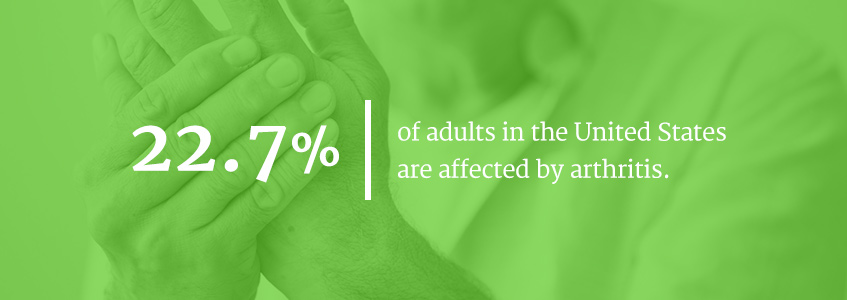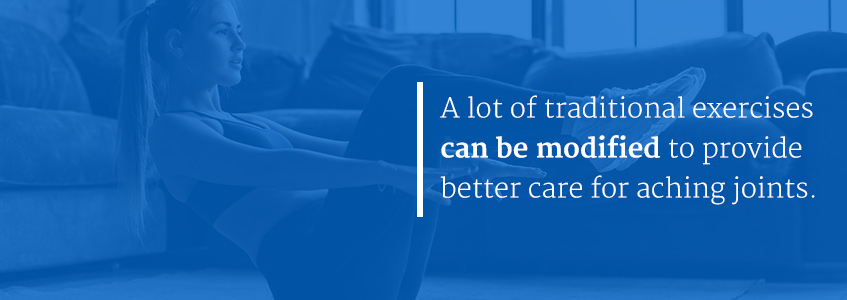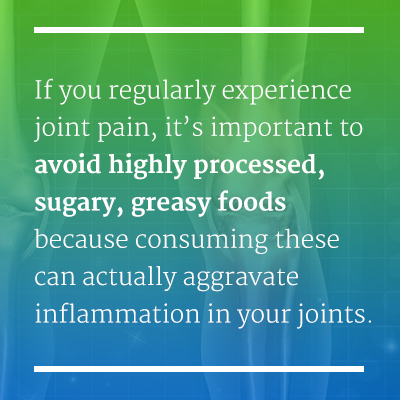Joints connect your bones to each other, creating the movement and motions that allow your body to do all of the things you need it to do during the day. When you’re feeling good, you probably don’t think about all of those movements. But if you’re one of the 14.6 million Americans who suffer from severe joint pain, then you are probably aware of every movement your joints make.
Joint pain can quickly go from being a minor inconvenience to making a major impact on your day-to-day life, especially if you aren’t sure how to cope with it. In fact, severe joint pain has been shown to result in high medical costs, loss of work time and diminished quality of life — both in the personal and professional sphere. At the very least, joint pain may likely have led you to be less active because you’re trying to avoid feeling pain. That’s normal, but the truth is that activity, when done correctly and in moderation, can actually ease joint pain.
Unfortunately, most people with joint pain don’t know how to properly incorporate exercise into their pain management plan. But it’s not too late to learn!
Causes of Joint Pain
First, it’s important to understand what causes joint pain. Why? Because the source of your pain is going to determine how you can workout and what kinds of movements may be beneficial or harmful to you.
Typically if you’re experiencing joint pain, it comes from one of four primary causes:
1. Arthritis
An umbrella term that includes many kinds of joint pain and disease, arthritis affects 22.7 percent of adults in the United States. People who have arthritis typically experience swelling, pain, decreased motion and stiffness in their joints. There are more than 100 types of arthritis, but some of the most common include osteoarthritis, rheumatoid arthritis and psoriatic arthritis.
2. Injury
Injury to a specific joint or the muscles surrounding the joint can cause joint pain. Joint pain can also result from a recent surgery, particularly one that was related to a joint, such as a shoulder or hip. When you’re injured, joint pain is most likely going to resolve itself as the injury heals. The activity you are able to do may also depend on the type of injury or surgery you have experienced, making it extremely important to consult a doctor before undertaking any kind of physical activity.
3. Tendonitis
Tendonitis causes pain when the tendons that connect the joints to your bones become inflamed. This typically pops up in one specific area of the body and is caused when that specific joint is overused, such as when a runner contracts patellar tendonitis because of the repeated motion of their kneecap while running.
4. Being Overweight
If your body is tasked with carrying around more than its fair share of pounds, then this can put additional strain on joints, resulting in significant pain. We’re not talking a lot of weight. In fact, losing just 11 pounds has been shown to decrease the risk for osteoarthritis (and the pain that accompanies it) by half.
10 Steps to Preventing Joint Pain During Exercise
You may not have control over the condition that is causing your joint pain, but you do have control over managing the pain and protecting yourself from making it worse. People used to think that one of the best ways to minimize joint pain was to stop exercising. But that’s simply not true. In fact, regular exercise can actually help to alleviate your pain by helping to stretch and move joints and the surrounding tendons and muscles. By keeping these parts loose, you can actually decrease your pain. And, even in adults whose pain is too great for exercise to completely erase it, having the increased endorphins that exercise provides helps them cope better with chronic pain by giving them increased energy and improving their outlook.
Note: While it is generally accepted that exercise is an important part of managing joint pain — except pain caused by injury — each individual case may vary. Therefore, it is important that you check with your doctor before beginning or altering any exercise routine.
If you’re looking to modify your workout routine — or get started on one — there are a few steps you can follow that will give you a quality workout that is good for your joints.
1. Buy Good Shoes
Everything in your body is connected. That means if you’re exerting too much pressure on your feet and ankles, it can impact joints all the way up into your legs and hips. When you work out, make sure you are wearing shoes that cushion your joints and absorb the impact of whatever motions you are making as you work out.
2. Don’t Forget to Warm Up
It’s something you’ve been told since elementary school, and with good reason. Warming up your muscles is vitally important to working out safely. And, when you already have joint pain, working out with stiff muscles can actually make your pain worse. If you aren’t sure where to start, a few minutes of walking will do. However, a good rule of thumb for warming up adequately is to do a smaller version of what you’re planning to do for your workout. For example, if you plan to run, walk for a few minutes. If you’re going to lift weights, march in place or do some squats to get the muscles warmed and ready for action. Hip circles and arm circles are also important to include in any warm up. If your ball-and-socket joints are cold, you’ll be hurting later.
3. Break up Your Workouts
Many people like to designate “arm days” and “leg days,” alternating between the muscle groups each day they workout. When you’re trying to prevent joint pain, it’s actually smarter to alternate between muscle groups during each workout, rather than putting a repetitive strain on one specific group. So, each time you work out, go back and forth between your upper and lower body. For example, after you complete a set of lunges, switch your focus to your arms with pushups or some free weights.
4. Combine High and Low Impact Exercises
High impact exercises are great when you want to lose weight, but too much of them and your joints won’t be thanking you later. However, some people shy away from low impact workouts because they believe they are less effective. That’s simply not true. Low impact exercise is a great way to lose weight and tone your muscles while protecting your joints from additional pain. The best thing to do is use a workout plan that incorporates both low and high impact exercises. For example, alternate interval training or running with walking or swimming. Also, consider incorporating yoga or pilates into your routine. Yoga has been shown to ease the pain of people suffering from joint pain due to rheumatoid arthritis, and pilates is designed to focus on joint stability and mobility.
5. Incorporate the Pool Into Your Workouts
Exercising in the pool takes a lot of pressure off of your joints. And, believe it or not, it’s a great way to get an intense workout when you don’t want to put a lot of strain on your joints. This is because the water provides you with more resistance, but there’s less gravity. So, your body is working hard against the resistance of the water, but it’s doing that without straining your joints and causing more pain. If you want to move your workouts to the pool, you can modify your existing workout, join a water aerobics class or check out the variety of pool-based workouts available online.
6. Modify Your Workouts
When it comes to exercise, variety actually is a good thing. A lot of traditional exercises can be modified to provide better care for aching joints. For example, instead of doing planks with hands pressed into the ground, position yourself on your forearms, which takes the pressure off of your shoulders and wrists. You can also use props to help keep unnecessary pressure off of your joints, such as putting yoga blocks under your hands when you’re doing pushups. Individuals suffering from joint pain may also benefit from shifting their weight off of their aching areas. For example, if your knees are a frequent problem, consider doing squats by moving your weight off of your knees and into your heels. Not only will this shift take pressure off of your knees, but it actually can help activate your glutes and tone your backside. Double bonus!
7. Use a Foam Roller
Foam rolling has been shown to help loosen fascia, the connective tissue that separates joints, organs and muscles in the body. When fascia are tight, joints are going to be more likely to ache. That’s where the foam roller comes in. When you use the foam roller, it brings more fluid into your fascia and keeps it loose and better able to move. When used three times a week, it can be a powerful tool in relieving joint pain. But, unfortunately, many people don’t know how to use a foam roller the right way. It’s important to understand how it works and the best way to use it before you begin, otherwise you may actually do more harm than good.
8. Always Stretch When You Finish
It can be tempting to cut your workout short and skip stretching, but when you’re suffering from joint pain, doing this can actually increase your pain later on. Why? Because having tight muscles can increase your joint pain, decrease motion and make future workouts more painful. While your muscles are warm from your workout, it’s important to spend time gently stretching out each muscle group, being careful to spend 20-30 seconds on each stretch. This will set you up for less pain the next time you hit the gym.
9. Use Heat
If you suffer from chronic joint pain, particularly arthritis, applying heat to the affected areas can increase blood flow, loosen muscles and decrease pain before beginning a workout. This may seem unusual since many people think that heat is something to apply after their workout to ease muscle pain, but it’s actually a valuable tool to use before a workout even starts. Simply grab a hot towel or a heat pack and treat the areas where you’re feeling pain.
10. Anti-Inflammatory Diet
Believe it or not, what you eat has a huge impact on your joints. And, if you’re a person who regularly experiences joint pain, you may want to consider adopting an anti-inflammatory diet to ease some of your discomfort. The good news is that an anti-inflammatory diet isn’t really a diet at all. It’s just a fancy way of saying to eat healthy, unprocessed foods, especially ones that are known to help reduce inflammation, such as kale, various berries, fish and whole grains. Almonds, avocado and foods containing the spice turmeric are also good choices. It’s also important to avoid highly processed, sugary, greasy foods because consuming these can actually aggravate inflammation in your joints.
Let the Metropolitan Pain & Spine Institute Help
Joint pain can be discouraging. It’s frustrating to feel like you can’t do the things you want to or move like you used to. When you’re a person who is used to regular, intense workouts, that can especially be discouraging and frustrating. But the good news about joint pain is that it’s actually beneficial to stay active. Activity helps to minimize — and sometimes alleviate — pain if it’s done the right way. With just a few small modifications, you can be just as active and just as dedicated to fitness as you were before your joint pain ever began.
But we realize that sometimes, even with the best of intentions, your joint pain just may be too much to manage on your own. Even with a modified workout plan and an anti-inflammatory diet, you may still be experiencing pain that makes it difficult to go about your daily activities. If you’re at that point, then maybe it’s time to ask for help.
At the Metropolitan Pain & Spine Institute, our board-certified spine and pain specialists are experienced in dealing with a variety of issues related to spine and joint pain. Relying on endoscopic spine procedures, we strive to provide the most comprehensive care in the least invasive manner possible. We believe that the best way to relieve your pain is to rely on minimally invasive procedures designed to correct what’s causing your pain and get you back to normal as soon as possible.
With three offices in New Jersey, the Metropolitan Pain & Spine Institute is conveniently located and offers friendly, compassionate staff who are ready to help you conquer the pain that has been controlling your life. Contact us to set up an appointment and see how we can help you to live pain-free.














Leave a Reply